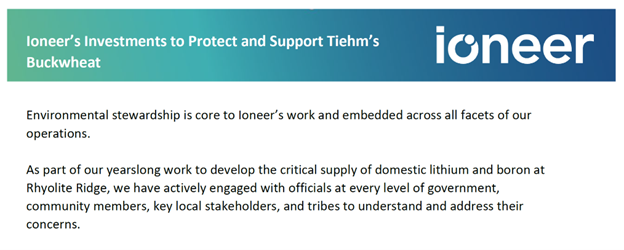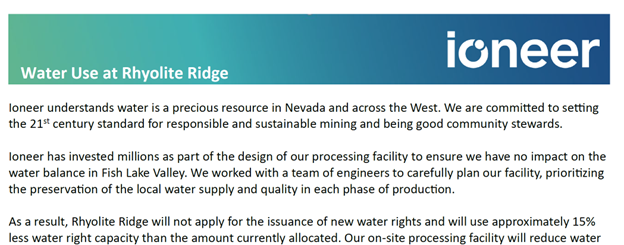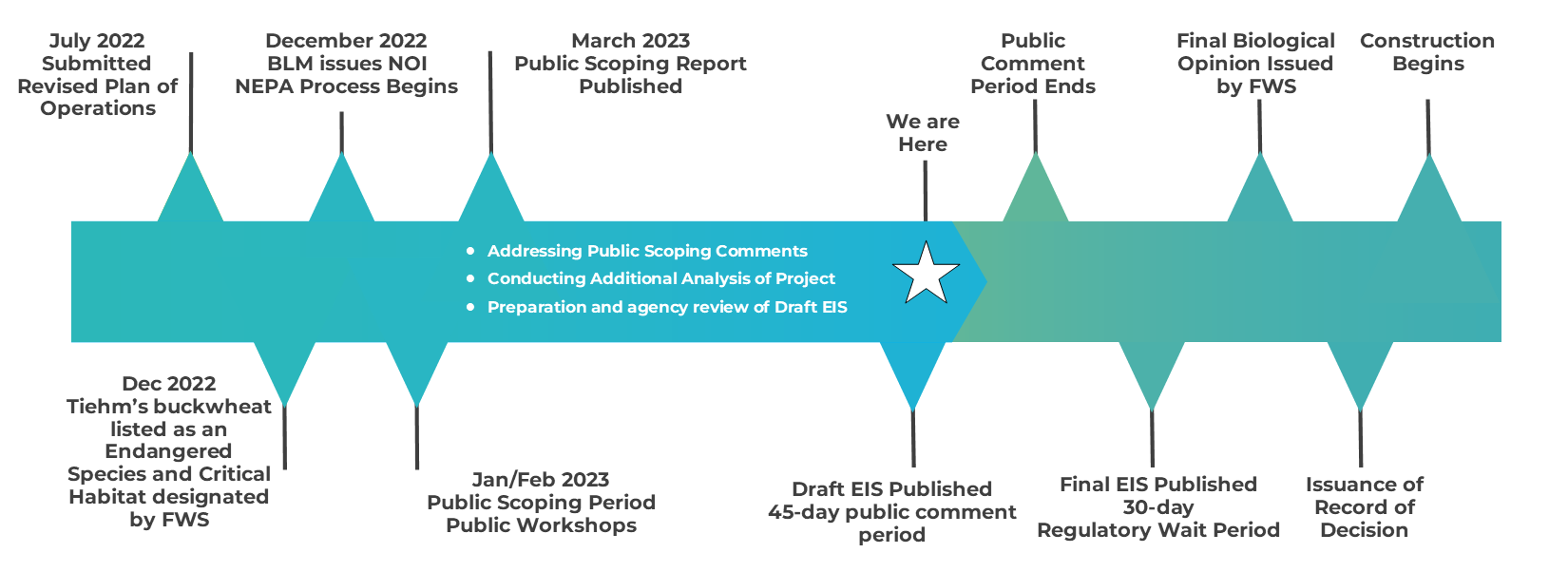“BLM takes next step on proposed Rhyolite Ridge Lithium-Boron Mine in Nevada”
BLM Press Release: April 12, 2024
The Bureau of Land Management published the Draft Environmental Impact Statement (Draft EIS) on April 16, 2024 and is currently seeking comments from interested parties.
The comment period ends on June 3, 2024.
NEPA Process Overview
Before construction at Rhyolite Ridge can begin, we must first obtain approval from the federal government under the rules of the National Environmental Policy Act, commonly known as the NEPA process.
In Preparation for the NEPA process, Ioneer has to date:
- Completed baseline studies and associated field work for 14 different resource areas of Rhyolite Ridge Project (e.g., air quality, biology, cultural resources, groundwater, recreation, socioeconomics, soils, and rangeland).
- Submitted the required Plan of Operations (Plan), which includes measures to be implemented to prevent unnecessary or undue degradation of public lands by operations authorized under the Mining Act (1872). It describes all aspects of the project including construction, operations, reclamation, and environmental protection measures.
PROCESS TIMELINE
Environmental stewardship is core to Ioneer’s mission. We are committed to investing time and resources into minimizing potential impacts of our project to local flora and fauna.
In August 2020, Ioneer submitted its initial Plan of Operations to the Bureau of Land Management (BLM). Following consultation and guidance from the US Fish and Wildlife Service and the BLM, we submitted a revised Plan of Operations to the BLM in July 2022 to reflect the modification of the initial mining quarry, avoiding all known populations of the Tiehm’s buckwheat.
In June, 2023, Ioneer reached agreement with Esmeralda County whereby Ioneer will be responsible for upgrading and maintaining the access road to the Project.
In December, 2023, Ioneer’s Construction Water Rights Application Package was approved by the Nevada Department of Water Resources (NDWR). This approved water right allows Ioneer the ability to pump 474 acre-feet per year through the construction period and will also be used to supplement operational water needs once operations commence.
During the next and final stages of the NEPA process, the federal government will assess and review our plans to mitigate any project impacts on the environment. Upon satisfaction of those conditions, approval is expected in 2024.
Any anticipated approval will specify what we must undertake to comply with all relevant laws during operations, and our plan to close and reclaim the area once mining is complete.
Overview of the NEPA Process – What’s Next?
Notice of Intent (NOI)
Bureau of Land Management (BLM) published a NOI to prepare an Environmental Impact Statement (EIS) for the Rhyolite Ridge project.
Public Scoping Period
The BLM held two public scoping meetings following the issuance of Notice of Intent to Draft an EIS.
Draft EIS (DEIS)
After initial public comments were received and reviewed, the BLM developed the Project’s DEIS that describes any potential impacts to the environment and how Ioneer plans to offset or mitigate them.
Public Comment
(Current Period)
The public is now provided another opportunity to review and comment on the Draft EIS. The BLM will use these comments to either conduct further analysis of the plan which may require us to modify any mitigation plans.
The BLM will hold two in person public meetings and one virtual meeting
to solicit feedback on the dates/times below:
May 6, 2024 5:00PM – Fish Lake Valley Community Center, Dyer, NV
and
May 7, 2024 5:00PM – Tonopah Convention Center, Tonopah, NV
May 9, 2024 – Virtual Meeting Via Zoom – Registration Details
You can read the Draft EIS here.
Final EIS (FEIS)
After comments on the DEIS have been collected and reviewed, the BLM will publish a FEIS and draft Record of Decision (ROD).
30-day Regulatory Wait Period
Issuance of Record of Decision
The BLM will then issue a Record of Decision (ROD) indicating acceptance of Ioneer’s plan. The public is then provided with an opportunity to object to this decision and the BLM is required to respond and address any concerns raised. Once this process is complete and Ioneer receives a final Record of Decision, the BLM can issue a final approved plan of operations.
Nevada Permits
In addition to the NEPA permitting process, Ioneer is required to receive permits from other authorities. Two key Nevada State permits are the Water Pollution Control Permit and the Class II Air Quality Permit, which were issued by the Nevada Department of Environmental Protection in July and June 2021, respectively. Accordingly, Rhyolite Ridge is the first developmental lithium project in Nevada to receive both of these two key permits.
Once all necessary permits, including the federal Record of Decision, are received, construction of the Rhyolite Ridge project can proceed.




